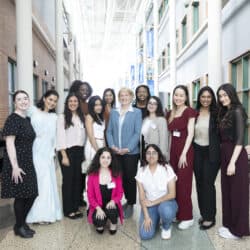Ten years ago, in a series called “Youth and the Future of Philanthropy,” The Philanthropist Journal asked how the sector could better serve, and include, young people. Here’s what some of the contributors to that series have to say now about how – and if – the sector has changed for the better.
Joanne Cave founded her own non-profit as a teenager. She was in high school and saw a need in her community, so she launched a young women’s empowerment organization called Ophelia’s Voice, which hosted workshops and events for girls and online resources on such topics as healthy sexuality, media awareness, and social justice. Cave was a youth recipient of a Governor General’s award for her work. But she was 14 when she started Ophelia’s Voice and faced some resistance in her mission. “It was quite an interesting experience for me to try to get other people to take me seriously, to articulate my vision,” she remembers.
“I was someone under the age of 18 who couldn’t even be properly on the board of the organization I started,” she says. She felt that youth voices, even those working hard to be taken seriously, were still too often disregarded.
That desire for respect was part of what led Cave to contribute to a series of articles published by The Philanthropist Journal in 2013 to explore how “conventional ways of thinking about philanthropy and civic engagement may not work for many young people in the contemporary context.” The series asked writers to put forward ideas to “open a dialogue about how to transform the philanthropy sector so that it may better serve young people.”
Cave wrote her piece hoping to encourage the sector to earmark or reserve seats for younger members on boards. She wanted organizations to ask, “Who do we want to be on our board, not next year, but in 10 years?”
The series heard from youth and their advocates from across the country. From board inclusivity to serving marginalized youth to intergenerational collaboration in the Jamaican diaspora philanthropy community to social media strategy (then an apple in most organizations’ eye), contributors highlighted myriad ways the philanthropic sector needed to change how it thought about young people – both those working and volunteering within the sector and those it serves.
The way in which we do things is as important as the things we do. The only way to fundamentally change the way philanthropy is done is to humbly have a conversation with people who have a different way of seeing the world.
Irwin Elman, youth advocate
A decade later, The Philanthropist Journal reached out to those same contributors again, seeking their thoughts on how – and if – the sector has changed for the better when it comes to youth issues.
Irwin Elman, a youth advocate based in Toronto, was one of the coordinators of the series. He still sees many of the same issues facing the sector today. While searching for solutions, he adds, it’s crucial for institutions to be open to difficult conversations. “The way in which we do things is as important as the things we do. The only way to fundamentally change the way philanthropy is done is to humbly have a conversation with people who have a different way of seeing the world.” And that, he says, includes youth.
Making leadership positions accessible
It’s no secret that sector leaders tend to be older. A 2021 Statistics Canada survey of charity and non-profit boards found that the median age of board members was 50 to 54. The US-based BoardSource non-profit governance index found that just 9% of board members were under 35 in 2021, with only 4% of board chairs being under 35.
Cave, who is now an Edmonton-based labour and employment lawyer, adds that boards still need to expand their thinking when they imagine an “ideal candidate” for a position. “Just because a younger candidate doesn’t look like what you expect, they might be really important developmentally,” she says.
Just because a younger [board] candidate doesn’t look like what you expect, they might be really important developmentally.
Joanne Cave, labour and employment lawyer
It’s a sentiment echoed by Keenan Wellar, who works with LiveWorkPlay, a grassroots charity with a mission to help communities “welcome and include people with intellectual disabilities, autistic persons, and individuals with a dual diagnosis to live, work, and play as valued citizens.”
“I don’t think anyone set up saying, ‘Oh, we only want retired white people on our boards,’” he says. But, he adds, a combination of factors entrenched a lack of board diversity for too long.
There has been some movement on the issue in the past 10 years, Cave says, noting “more intentionality around shared power and decision-making.”
Wellar says that boards are successful when they offer flexibility and show a willingness to use technology, a sentiment echoed in an article in the Stanford Social Innovation Review, which encourages organizations to be “tight on aims, loose on everything else” when seeking applicants.
Welcoming youth to work and volunteer in the sector
When it comes to attracting young talent, either as employees or volunteers within the sector, there is still much to learn, according to Wellar.
“I was a little frustrated of misconceptions about younger people not being interested in volunteering,” he says of the underlying motivation for his 2013 article. “It is surprising to see how many voluntary organizations approach volunteers with a very limiting set of opportunities,” Wellar wrote at the time, pointing to “unbending organizational cultures and highly insular approaches to communication.”
Don’t put limits on the nature of volunteerism that aren’t truly necessary. The days of treating the volunteer process like an employment application are over.
Keenan Wellar, LiveWorkPlay
Ten years later and the co-leader and director of communications at LiveWorkPlay, Wellar has learned many of his own lessons. “Don’t put limits on the nature of volunteerism that aren’t truly necessary,” he says, pointing to set schedules or minimum hour requirements. “The days of treating the volunteer process like an employment application are over.”
And it’s not that younger generations are not interested in volunteering. According to 2018 Statistics Canada data, the generation dubbed Generation Z (or iGens), born after 1996, had the highest rate of participation in formal volunteer activities in the country, at 52%.
Wellar has found that people aren’t signing up to volunteer to pad their resumés. In recent surveys about what motivated people to volunteer, he says, the top reasons were “it looked like it would be fun” and “it aligns with my values.”
Better serving the youth the sector seeks to help
Back in 2013, Kim Snow was years into her career working with youth in care. She wrote about how youth in care grapple with what’s been dubbed a “stigmatized identity peg,” meaning they’re expected to be criminals or outcasts from the outset, based on ill-informed but all-too-pervasive societal stereotypes. “Philanthropists wishing to engage with stigmatized groups are well served by forming an alliance to confront prejudice and challenge stereotypes,” she wrote.
From her perspective, not much has changed. “It’s a problem that is a feature of how we marginalize the care system,” she says today. “The structural pieces necessary to do this kind of advocacy are just not well recognized.”
There are tens of thousands of youth in care across the country, about half of whom are Indigenous. They face a range of challenges, from lack of continuity in care or housing to stereotyping to mental health challenges, including as they “age out” of the system, still young and still facing hurdles, but with less support.
For Snow, who is now an associate professor in the School of Child and Youth Care at Toronto Metropolitan University, not enough has changed when it comes to marginalization.
Elman agrees: “If you ask young people who you were trying to change things for – ask them the same questions as 20 years ago – you will hear the same answers.”
Fund the advocacy, not the product. There needs to be [core] funding to sustain.
Kim Snow, School of Child and Youth Care, Toronto Metropolitan University
Ten years ago, Snow highlighted the need for philanthropists to embrace the idea of providing core funding. “When seeking to engage with a marginalized population, it is essential to commit sufficient time in order to build capacity. This often means committing to longer-term funding,” she wrote.
“Fund the advocacy, not the product,” she says now. “There needs to be funding to sustain.” For Snow, it is essential to fund organizations, especially youth-led organizations, to grow and develop, rather than to only fund a measurable output they can report back on.
And, she adds, many organizations still need to spend more time asking and listening to youth about what they need. “Philanthropy will get better if they engage. They will grow from this experience. They will identify how they can be allies and activities if they don’t do it in a tokenizing way.”
Funding young people to do the work
Snow highlights the importance of what’s known as “first voice advocates,” defined as “people with lived experience in out-of-home child protection system placements who advocate for change in their communities and jurisdictions.”
She would like to see more investment in youth leading initiatives that will benefit them, but she also wants to see more work done to build skills in marginalized young people, from grant-proposal-writing workshops for young people in care to board leadership development. Without that investment, she says, funding first voice advocacy or youth-led initiatives can “inadvertently set them up to fail. They don’t have the infrastructure.” She points to personal infrastructure in the way of training, education, and lived experiences that allow individuals to thrive. “Building the skills pays off in so many ways.”
Lived experience is a legitimate source of knowledge – and it’s a legitimate source of knowledge for funders too.
Irwin Elman
One example of first voice advocates, highlighted in a 2023 paper in the International Journal of Child, Youth and Family Studies, is the National Council of Youth in Care Advocates, a diverse group of people from across Canada, each with lived experience in the child protection system.
The group, dubbed a “national lived experience advocacy movement,” values lived experience as expertise and has met with government ministers, senators, members of parliament, child and youth advocates, policy advisors, and others to advocate systemic change, including the creation of what are known as the Equitable Standards for Transitions to Adulthood for Youth in Care, the first set of such standards in Canada – making it possible for organizations to rely on the shared knowledge of people who themselves dealt with these issues.
Elman says it’s crucial to recognize that youth in care have a lot of insights into how they, as a group, could be supported. “Lived experience is a legitimate source of knowledge – and it’s a legitimate source of knowledge for funders too,” he says.
Intergenerational collaboration
In 2013, Tka Pinnock was in her mid-20s and active in the non-profit community, working with groups that included Tropicana Community Services, Jamaica 50 Celebration Inc., and the Markham African Caribbean Canadian Association. At the time, she wrote, she was interested in “ways in which older diaspora members mentor and support young people to become effective agents of change in their communities at home and abroad.”
“Older allies can use their legitimacy – their social capital – to create a space of real power for young people. This spending (or sharing) of social currency goes beyond mere advocacy and insists on older allies giving up their positions of power and their grasp on power so that young people can occupy those spaces,” she wrote.
Pinnock, now a PhD candidate in the Department of Politics at York University, no longer sees things quite the same way. “My assumption was legitimacy and authenticity had to be given. With a decade of experience, I don’t think it matters so much,” she says. “I think it’s sufficient for young people to say what they’re doing is valuable.”
I don’t know that I’ve seen a giving up of power. I see a lot of young people now doing their own things – starting their own organizations, rethinking how community work is done, rethinking what community even means to them.
Tka Pinnock, PhD candidate, Department of Politics, York University
“Intergenerational collaboration is not a requirement for their ideas to take spark and become movements,” she says, pointing to Black Lives Matter as an example.
“I don’t know that I’ve seen a giving up of power,” she says of philanthropic organizations she’s familiar with. “I see a lot of young people now doing their own things – starting their own organizations, rethinking how community work is done, rethinking what community even means to them.”
Showcasing the sector to young people
Ten years ago, there was no TikTok. The word “tweet” had only just been added to the Oxford English Dictionary. Facebook had less than half the number of monthly users as it does today.
“The popularity of social networking websites and new technologies raises important questions about the structure of some social institutions,” wrote April McAllister back in 2013, when she was still in school working toward becoming a social worker. “Older generations must be open to exploring the potential of new technology and adapting their current political and civic practices to use these technologies.”
McAllister had already identified that institutions – charitable and philanthropic organizations included – were often slow to participate and adapt to new ways of doing things.
Shannon Daley saw a similar trend. She was a first-year university student taking a writing class when she saw The Philanthropist’s call for pitches. “I wanted to try and write an article for the first time,” she remembers. Her piece focused on the lessons learned from the movement dubbed “Kony 2012” – a viral online campaign to raise awareness about the actions of Ugandan guerrilla leader Joseph Kony. A phone survey by Pew Research Center in the days following the release of the campaign found that nearly 60% of young adults were aware of it.
Social media, Daley says, clearly “has an even greater ability to capture attention now,” but she adds that for organizations seeking to get youth to care about an issue or become involved, engagement often begins – but shortly thereafter ends – online. She’d like to see more work put in to ensure organizations don’t just generate online buzz, but also translate it into meaningful action.
Reading the article over again, I was struck with how much more social media is in everyday use than it was 10 years ago.
April McAllister, former social worker
McAllister sees many changes in the way organizations use social media. “Reading the article over again, I was struck with how much more social media is in everyday use than it was 10 years ago,” she says. “It is interesting to compare the beginnings and now all the other social media platforms that have become since then and what has been used for the good and the bad.”
Of course, social media use has skyrocketed since 2013, with some estimates suggesting that nearly 90% of Canadians now use at least one platform.
For young people, McAllister says, there have been positive changes because of the pandemic. “As a result of COVID, technology was further relied on, which in turn was geared towards populations that were already using and comfortable with social media,” she says. “Organizations were forced to conduct day-to-day business differently and rely heavily on social media – and this likely had a positive effect on youth who were already comfortable with these technologies.”
Still searching for fundamental change
Though each writer approached the topic of youth engagement in different ways, the myriad responses in the 2013 series highlight the importance of engaging with young people to further the goals of philanthropy, especially when organizations seek to serve younger populations.
The authentic incorporation of youth perspectives, engaging or hiring youth with lived experience, investing in capacity building for young people, and fostering relationships with adult allies – all showed up as themes in the series, and all have been identified in more recent work on engaging youth in philanthropy.
I think what philanthropists can look towards is their influence. Unless things fundamentally change, everything else is just tinkering with the system.
Irwin Elman
There’s a long way to go, though, according to the contributors who homed in on these issues 10 years ago. Some progress has been made and changes are occurring – but there are still opportunities for organizations and funders to critically re-examine the way they relate to youth.
“There’s a difference between change and influence,” Elman says, noting that influence is longer-term change. “I think what philanthropists can look towards is their influence. Unless things fundamentally change,” he says, “everything else is just tinkering with the system.”


